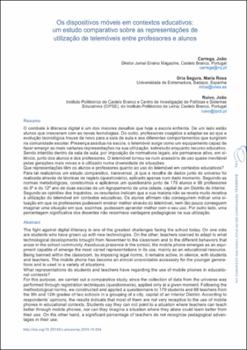Os dispositivos móveis em contextos educativos: um estudo comparativo sobre as representações de utilização de telemóveis entre professores e alunos
Fecha
2018Resumen
O combate à iliteracia digital é um dos maiores desafios que hoje a escola enfrenta. De um lado estão
alunos que cresceram com as novas tecnologias. Do outro, professores coagidos a adaptar-se ao que a
evolução tecnológica trouxe de novo para a sala de aula e aos diferentes comportamentos que surgiram
na comunidade escolar. Presença assídua na escola, o telemóvel surge como um equipamento capaz de
fazer emergir as mais variadas representações na sua utilização, sobretudo enquanto recurso educativo.
Sendo interdito dentro da sala de aula, por imposição de normativos legais, ele permanece ativo, em silêncio,
junto dos alunos e dos professores. O telemóvel tornou-se num acessório de uso quase inevitável
pelas gerações mais novas e é utilizado numa diversidade de situações.
Que representações têm os alunos e professores quanto ao uso do telemóvel em contextos educativos?
Para tal realizámos um estudo comparativo, transversal, já que a recolha de dados junto do universo foi
realizada através de técnicas de registo (questionário), aplicado apenas num dado momento. Seguindo as
normas metodológicas, construímos e aplicámos um questionário junto de 179 alunos e 88 professores
do 9º e do 12º ano de duas escolas de um Agrupamento de uma cidade, capital de um Distrito do Interior.
Segundo as opiniões dos inquiridos, os resultados indicam que a sua maioria não se revela muito recetiva
à utilização do telemóvel em contextos educativso. Os alunos afirmam não conseguirem indicar uma situação
em que os professores pudessem ensinar melhor através do telemóvel, nem tão pouco conseguem
imaginar uma situação em que, sozinhos, pudessem aprender melhor com o seu uso. Por outro lado, uma
percentagem significativa dos docentes não reconhece vantagens pedagógicas na sua utilização. The fight against digital illiteracy is one of the greatest challenges facing the school today. On one side
are students who have grown up with new technologies. On the other, teachers coerced to adapt to what
technological developments brought from November to the classroom and to the different behaviors that
arose in the school community. Assiduous presence in the school, the mobile phone emerges as an equipment
capable of emerge the most varied representations in its use, mainly as an educational resource.
Being banned within the classroom, by imposing legal norms, it remains active, in silence, with students
and teachers. The mobile phone has become an almost unavoidable accessory for the younger generations
and is used in a variety of situations.
What representations do students and teachers have regarding the use of mobile phones in educational
contexts?
For this purpose, we carried out a comparative study, since the collection of data from the universe was
performed through registration techniques (questionnaire), applied only at a given moment. Following the
methodological norms, we constructed and applied a questionnaire to 179 students and 88 teachers from
the 9th and 12th grades of two schools in a grouping of a city, capital of an Interior District. According to
respondents’ opinions, the results indicate that most of them are not very receptive to the use of mobile
phones in educational contexts. Students say they can not point to a situation where teachers can teach
better through mobile phones, nor can they imagine a situation where they alone could learn better from
their use. On the other hand, a significant percentage of teachers do not recognize pedagogical advantages
in their use.





